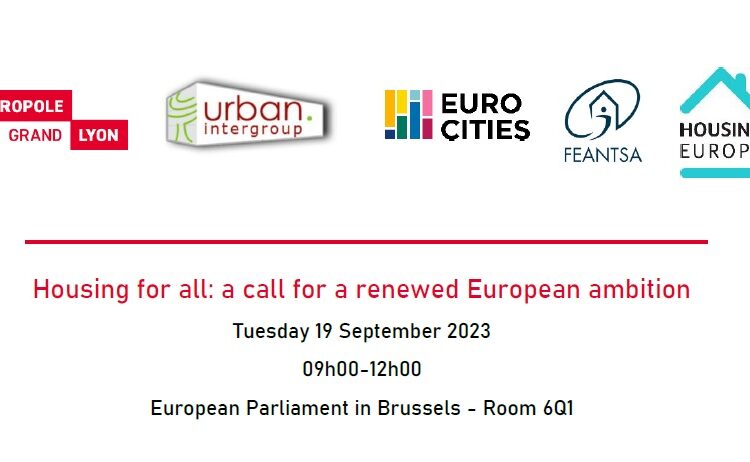Lyon Metropole, the URBAN Intergroup at the European Parliament, Eurocities, FEANTSA and Housing Europe, the Federation of Public, Cooperative and Social Housing, are pleased to invite you to attend a high-level event on housing, poor housing and homelessness organised on Tuesday 19 September 2023, in the European Parliament in Brussels.
As the mandates of the current European Parliament and European Commission draw to a close and 2024 will see the shaping of new political priorities for the European Union, it is now time to take stock of what has been achieved since 2019 and what remains to be achieved to ensure all European citizens have access to affordable and decent housing.
Aiming at providing political impetus for the 2024-2029 European Commission and European Parliament mandates, this high-level event will tackle three different aspects of the housing crisis: the difficulty for lower-income “front-line” workers to find affordable housing, homelessness and indecent housing, and the issue of the financialisation of housing and its impact in cities.
REGISTRATION
To attend the event, please register before Thursday 14 September using the following link.
PROGRAMME
08h40-09h00 Welcome coffee
09h00-09h05 Welcome and opening remarks
• Mr. Jan Olbrycht, Member of the European Parliament, President of the URBAN Intergroup
09h05-09h50 Employment and housing for “frontline” workers
• Discussion led by Ms. Nathalie Guri, Eurocities Projects and Knowledge sharing Director
• Ms. Alison Gilliland, Dublin City Councillor
• Ms. Lenka Antalová Plavuchová, Bratislava Deputy-Mayor (invited)
• Ms. Katrin Langensiepen, Member of the European Parliament, Vice-president of the Committee on Employment and Social Affairs
09h50-09h55 Testimony
• Ms. Marie Linder, President of the International Union of Tenants (IUT)
09h55-10h40 Poor housing and homelessness
• Discussion led by Mr. Freek Spinnewijn, FEANTSA Director
• Mr. Renaud Payre, Lyon Metropole Vice-president in charge of Housing, Social Housing and Urban Policy
• Mr. Joan Ramon Riera, Barcelona Housing Commissioner
• Ms. Estrella Durá Ferrandis, Member of the European Parliament
10h40-10h50 Break
10h50-10h55 Keynote
• Ms. Kim van Sparrentak, Member of the European Parliament
10h55-11h40 The financialisation of housing
• Discussion led by Mr. Bent Madsen, Housing Europe President
• Mr. Stephan Machulik, Berlin Permanent Secretary for Housing and Tenant Protection
• Ms. Emily Marion Clancy, Bologna Deputy Mayor in charge of Housing, Climate Assemblies and Climate Office, Night Economy, Equal Opportunities and Anti-Discrimination Policies
11h40-12h00 Conclusions and Declaration signature ceremony
• Mr. Iñaqui Carnicero, Secretary General of Urban Agenda, Housing and Architecture in the Spanish Ministry of Transport, Mobility and Urban Agenda
• Mr. Christophe Collignon, Minister for Housing, Local Government and Urban Affairs, Wallonia
• Ms. Fabienne Keller, Member of the European Parliament, Vice-president of the URBAN Intergroup
Any questions may be addressed to asmethurst@grandlyon.com or zuzannaewa.tatara@europarl.europa.eu.
